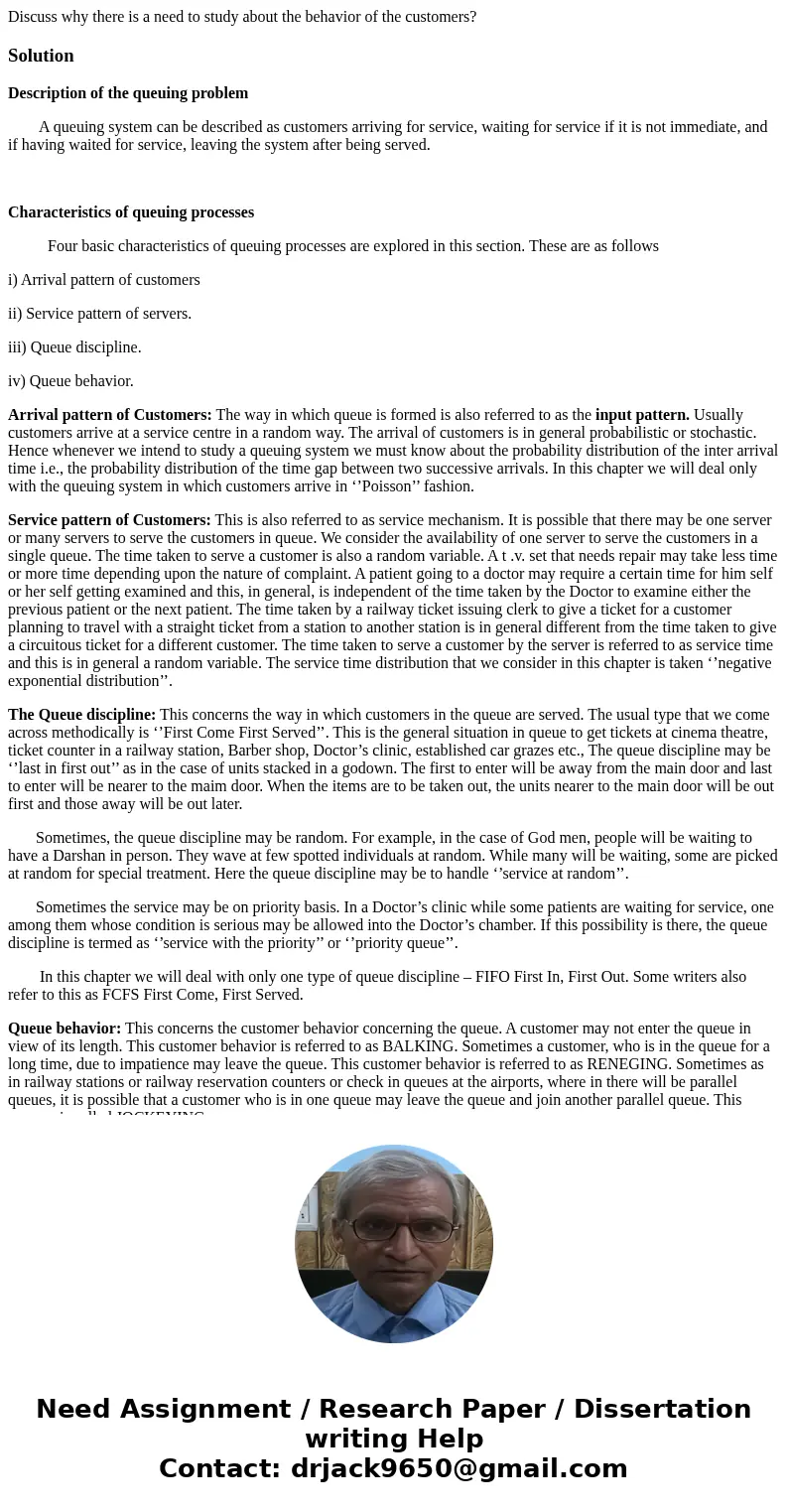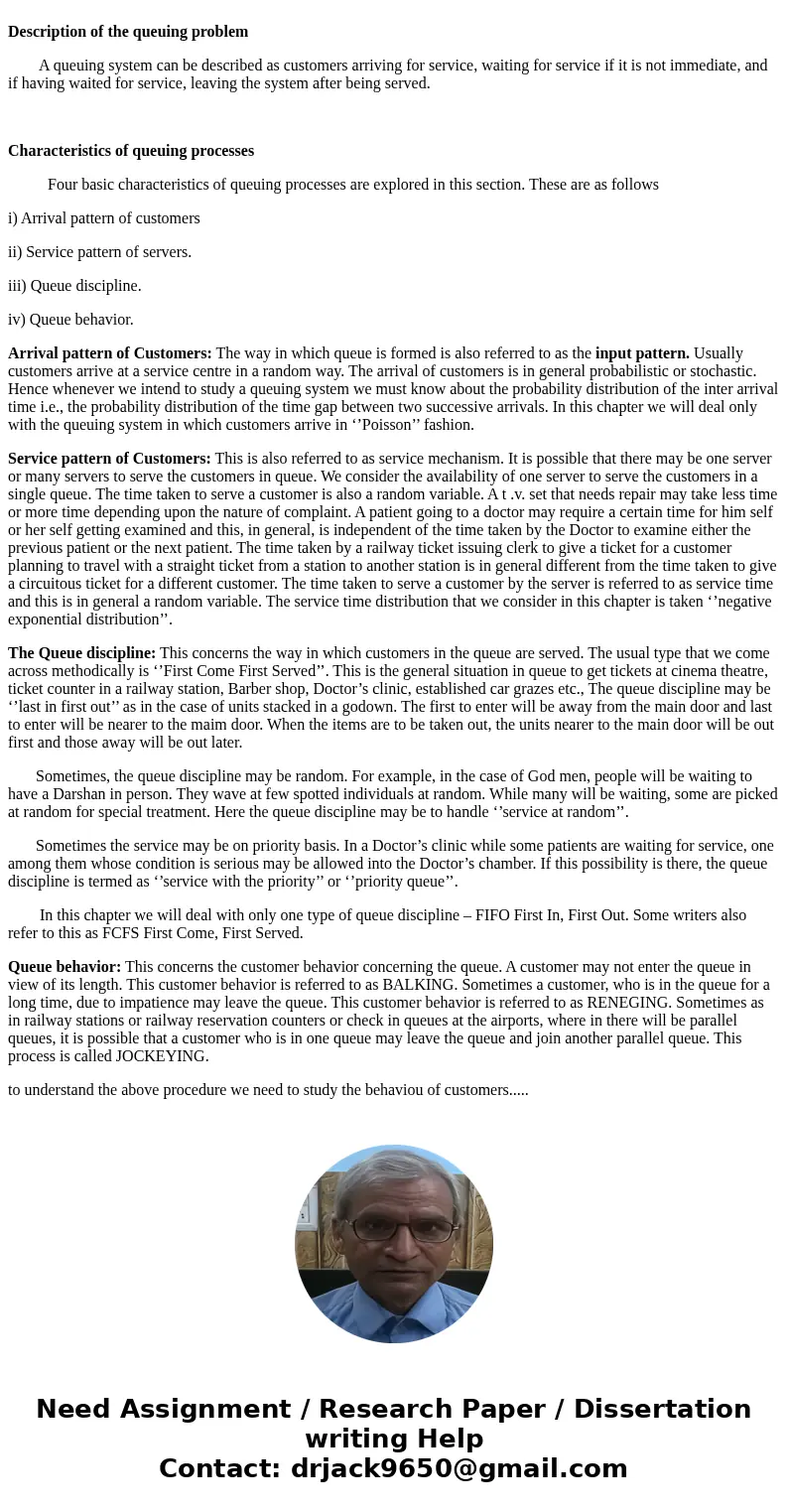Discuss why there is a need to study about the behavior of t
Discuss why there is a need to study about the behavior of the customers?
Solution
Description of the queuing problem
A queuing system can be described as customers arriving for service, waiting for service if it is not immediate, and if having waited for service, leaving the system after being served.
Characteristics of queuing processes
Four basic characteristics of queuing processes are explored in this section. These are as follows
i) Arrival pattern of customers
ii) Service pattern of servers.
iii) Queue discipline.
iv) Queue behavior.
Arrival pattern of Customers: The way in which queue is formed is also referred to as the input pattern. Usually customers arrive at a service centre in a random way. The arrival of customers is in general probabilistic or stochastic. Hence whenever we intend to study a queuing system we must know about the probability distribution of the inter arrival time i.e., the probability distribution of the time gap between two successive arrivals. In this chapter we will deal only with the queuing system in which customers arrive in ‘’Poisson’’ fashion.
Service pattern of Customers: This is also referred to as service mechanism. It is possible that there may be one server or many servers to serve the customers in queue. We consider the availability of one server to serve the customers in a single queue. The time taken to serve a customer is also a random variable. A t .v. set that needs repair may take less time or more time depending upon the nature of complaint. A patient going to a doctor may require a certain time for him self or her self getting examined and this, in general, is independent of the time taken by the Doctor to examine either the previous patient or the next patient. The time taken by a railway ticket issuing clerk to give a ticket for a customer planning to travel with a straight ticket from a station to another station is in general different from the time taken to give a circuitous ticket for a different customer. The time taken to serve a customer by the server is referred to as service time and this is in general a random variable. The service time distribution that we consider in this chapter is taken ‘’negative exponential distribution’’.
The Queue discipline: This concerns the way in which customers in the queue are served. The usual type that we come across methodically is ‘’First Come First Served’’. This is the general situation in queue to get tickets at cinema theatre, ticket counter in a railway station, Barber shop, Doctor’s clinic, established car grazes etc., The queue discipline may be ‘’last in first out’’ as in the case of units stacked in a godown. The first to enter will be away from the main door and last to enter will be nearer to the maim door. When the items are to be taken out, the units nearer to the main door will be out first and those away will be out later.
Sometimes, the queue discipline may be random. For example, in the case of God men, people will be waiting to have a Darshan in person. They wave at few spotted individuals at random. While many will be waiting, some are picked at random for special treatment. Here the queue discipline may be to handle ‘’service at random’’.
Sometimes the service may be on priority basis. In a Doctor’s clinic while some patients are waiting for service, one among them whose condition is serious may be allowed into the Doctor’s chamber. If this possibility is there, the queue discipline is termed as ‘’service with the priority’’ or ‘’priority queue’’.
In this chapter we will deal with only one type of queue discipline – FIFO First In, First Out. Some writers also refer to this as FCFS First Come, First Served.
Queue behavior: This concerns the customer behavior concerning the queue. A customer may not enter the queue in view of its length. This customer behavior is referred to as BALKING. Sometimes a customer, who is in the queue for a long time, due to impatience may leave the queue. This customer behavior is referred to as RENEGING. Sometimes as in railway stations or railway reservation counters or check in queues at the airports, where in there will be parallel queues, it is possible that a customer who is in one queue may leave the queue and join another parallel queue. This process is called JOCKEYING.
to understand the above procedure we need to study the behaviou of customers.....


 Homework Sourse
Homework Sourse